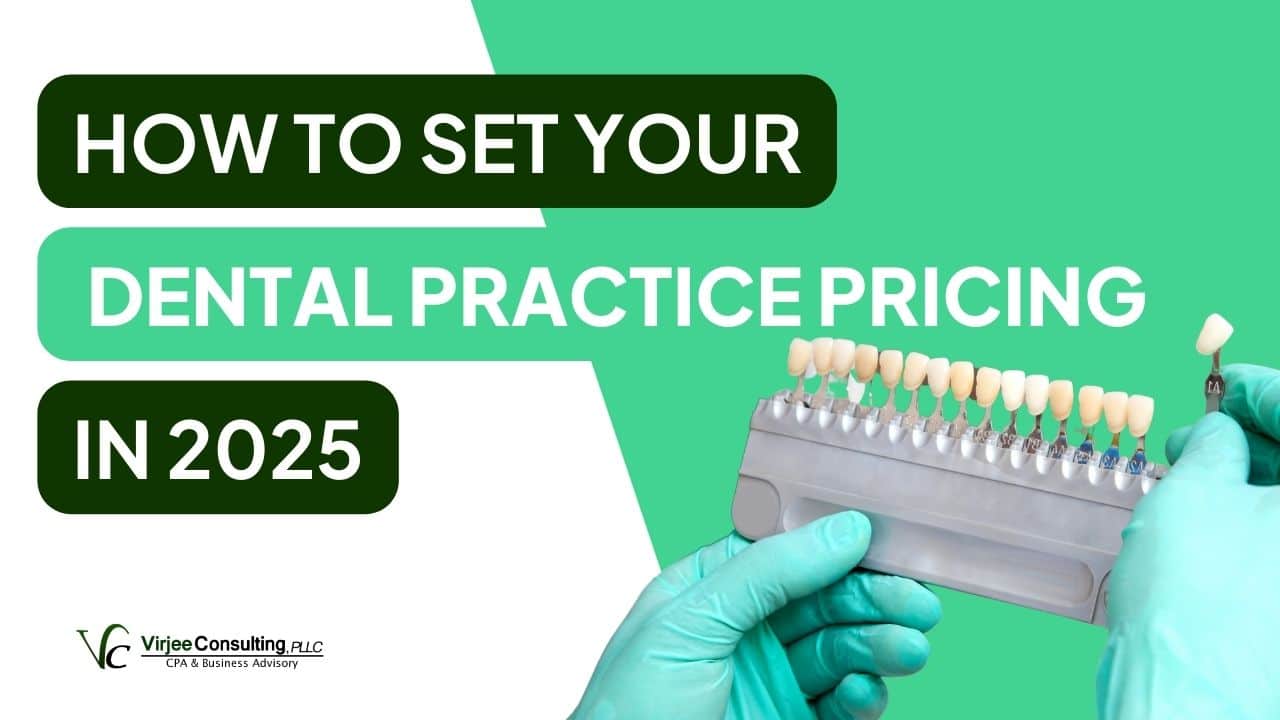Have you ever had a patient raise their eyebrows and ask, “A thousand dollars… for one little crown?”
We hear it all the time!
High-value procedures like implants or Invisalign often come with sticker shock.
But that doesn’t mean your fees are too high; it just means it’s time to back your pricing with more confidence and a smart strategy.
In 2025, smart pricing is not just about staying competitive, it’s about staying profitable.
This guide breaks down how we help our clients set dental practice pricing, so you can confidently set, explain, and stand behind your prices.
Step 1: Know Your Numbers (Like, Really Know Them)
Before you can defend your pricing, you have to understand what it costs to run your practice by the hour.
Here’s how to calculate it:
Monthly Expenses
Include team salaries, rent or mortgage, insurance, utilities, marketing, supplies, lab fees—everything it takes to keep your doors open.
Clinical Hours
Add up the total number of hours your practice is open each month.
Now divide your total expenses by your clinical hours. That’s your hourly cost to operate.
Example:
If it costs you $68,000 monthly to operate and you’re open 160 hours, that’s $425 per hour. If you charge $1,000 for a crown that takes an hour, your profit is $575 before taxes or reinvestment.
If you’ve never done this math before, you might be undercharging without realizing it.
Step 2: Understand the National Trends
Even if your practice is running smoothly, national trends in costs and revenue benchmarks should still inform your pricing decisions.
Why?
Because your expenses -and your patients’ expectations – don’t exist in a vacuum.
According to the ADA and Dental Economics, here’s what’s shaping dental pricing across the country in 2025:
1. Overhead Should Stay Around 60–65% of Revenue
This is the benchmark for a healthy, profitable dental practice. That means if you collect $100,000 a month, no more than $65,000 should be going toward operating costs (like staff wages, rent, supplies, lab fees, and marketing).
Once overhead starts creeping above 70%, profitability becomes tight, and it’s often a red flag that your pricing needs a review.
2. Staffing Costs Are Rising
There’s a national shortage of dental assistants, hygienists, and front office staff, and practices are paying more to attract and retain talent. The ADA reports that in 2024–2025, dental team wages have outpaced inflation, and many practices are offering bonuses and added benefits to stay competitive.
If your pricing hasn’t changed in the last 12–18 months, you might be absorbing these extra staffing costs instead of passing them through your fee schedule where appropriate.
3. Lab and Supply Costs Are Up (Again)
Lab fees, impression materials, digital scanners, and sterilization equipment – almost every supply category has been affected by ongoing supply chain issues and inflation. According to Dental Economics, labs themselves have increased prices by 5–10% in the past year alone. If you’re not adjusting your fees accordingly, you’re quietly watching your profit margins shrink.
4. Annual Fee Increases of 3-5% Are Now the Norm
This isn’t about greed. It’s about sustainability. Regular, modest increases help you stay ahead of rising costs and avoid massive catch-up adjustments that patients will notice and resist. Patients are more receptive to small annual increases than to a sudden 15% jump after three years of flat fees.
If you’re not reviewing and adjusting your fees at least once a year, you may already be undercharging.
5. Patients Expect More – So You Need to Charge Accordingly
Patients today expect online booking, shorter wait times, tech-enabled diagnostics, flexible payment options, and a top-tier service experience. Meeting those expectations requires real investment. Your pricing should reflect not just the procedure itself, but the elevated level of care you’re delivering.
Step 3: Bring Your Team Into the Pricing Conversation
If your team doesn’t understand why you charge what you do, they can’t explain it to patients, and they might not feel confident backing you up.
Show your staff what it costs to deliver care.
Break down the cost of a crown—materials, lab fees, sterilization time, clinician time—and why that $1,000 fee isn’t random.
When your team understands the pricing structure, they’ll be able to communicate it with confidence, not hesitation.
Role-play these conversations together.
For example:
“We use one of the top labs in the country. That makes a difference in how long this restoration will last.”
“This isn’t just a filling—it’s a long-term fix, custom-designed for your bite and smile.”
Step 4: Make It About Value, Not Just Cost
You’re not selling procedures. You’re solving problems.
When a patient hesitates at the cost, don’t jump into justification mode. Start with curiosity.
“What are your goals for your teeth and smile?”
When they say things like “I want to chew comfortably again” or “I’m tired of hiding my smile,” that allows you to position your treatment plan as a solution, not a sales pitch.
The crown isn’t $1,000 because that’s what everyone charges—it’s $1,000 because it fixes something they’ve told you matters.
Step 5: Review and Adjust Fees Regularly
You wouldn’t recommend a treatment plan from 2019. So why would you use a fee schedule from then?
In today’s economy, you should review your pricing at least once a year.
Look at:
- Inflation’s impact on your overhead
- Local competitive rates
- Your profit margin per procedure
- ADA fee surveys and regional benchmarks
Raising fees doesn’t make you greedy. It makes your practice sustainable and gives you the resources to keep investing in quality care!
Final Thoughts: Price With Purpose, Not Guesswork
If you’ve been setting prices based on what nearby practices charge—or what you think patients will tolerate—it’s not necessarily wrong. But it’s likely not enough in today’s economic environment.
Your pricing needs to be rooted in facts: your overhead, your profit goals, your team’s time, and the quality of care you provide.
When those numbers are clear, pricing becomes less emotional and more strategic.
Here’s what successful practices are doing in 2025:
- Running the numbers regularly to align fees with rising costs and realistic margins
- Training their team to communicate confidently and consistently about pricing
- Positioning treatment around value and outcomes, not just cost
This isn’t about overcharging. It’s about making sure your pricing reflects the real investment you put into every procedure, so you can hire, grow, and reinvest in your practice without cutting corners.
If you’re ready to take the guesswork out of your pricing, we can help.
At Virjee Consulting, we work with dental practices to build pricing strategies that are defensible, data-backed, and built for long-term success.
Let’s make your pricing a strength, not a stressor. Use the form below to get in touch with our team and schedule an introductory call. That’s what we’re here for!
Until next time.

